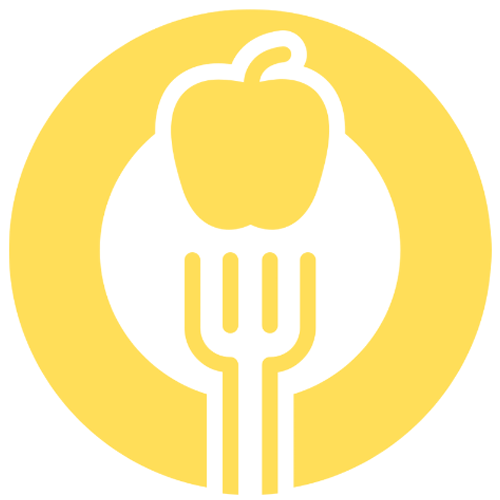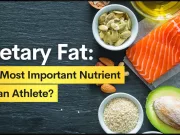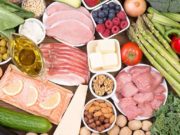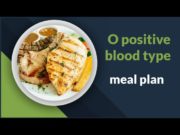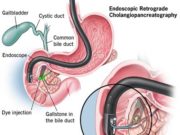Best diet to lower blood pressure, a phrase that resonates with millions seeking healthier lives. High blood pressure, a silent killer, can lead to serious health complications, but dietary changes can play a crucial role in its management. This guide explores the power of food in combating hypertension, unveiling the secrets to a heart-healthy lifestyle.
Understanding the connection between diet and blood pressure is essential. The DASH diet, a cornerstone of blood pressure management, emphasizes fruits, vegetables, whole grains, and lean protein. This approach not only lowers blood pressure but also promotes overall well-being.
Understanding High Blood Pressure
High blood pressure, also known as hypertension, is a condition where the force of blood pushing against the walls of your arteries is consistently too high. It is a common health problem that can lead to serious complications if left untreated.
The Role of Diet in Managing Blood Pressure
Diet plays a crucial role in managing blood pressure. By making healthy food choices, you can help lower your blood pressure and reduce your risk of developing serious health problems.
Dietary Approaches to Lower Blood Pressure
A healthy diet is essential for managing high blood pressure. The DASH diet (Dietary Approaches to Stop Hypertension) is a well-researched dietary pattern specifically designed to lower blood pressure.
The DASH Diet
The DASH diet focuses on reducing sodium intake while increasing potassium, magnesium, and calcium. It emphasizes fruits, vegetables, whole grains, and low-fat dairy products, while limiting saturated and unhealthy fats, cholesterol, and added sugars.
The DASH diet provides a comprehensive guide for planning meals and snacks, outlining the recommended servings for each food group:
- Fruits: 4-5 servings per day
- Vegetables: 4-5 servings per day
- Grains: 6-8 servings per day, with at least half being whole grains
- Low-fat dairy: 2-3 servings per day
- Lean meats, poultry, fish: 2-3 servings per day
- Nuts, seeds, legumes: 4-5 servings per week
- Fats and oils: 2-3 servings per day
- Sweets: 5 servings per week or less
Comparing the DASH Diet with Other Diets
The DASH diet shares similarities with other popular diets for blood pressure management, such as the Mediterranean diet. Both emphasize fruits, vegetables, whole grains, and lean protein sources. However, the DASH diet specifically focuses on reducing sodium intake, which is not as emphasized in the Mediterranean diet. The Mediterranean diet, on the other hand, emphasizes olive oil and fish consumption, which are not specifically highlighted in the DASH diet.
The DASH diet is a balanced and evidence-based approach to lowering blood pressure. It offers a practical framework for making healthy dietary choices that can contribute to overall well-being.
Key Food Groups for Lowering Blood Pressure
A balanced diet plays a crucial role in managing blood pressure. Certain food groups are particularly beneficial for lowering blood pressure and promoting heart health.
Foods to Include in Your Diet for Lowering Blood Pressure
| Food Group | Benefits for Blood Pressure | Examples of Foods | Serving Suggestions |
|---|---|---|---|
| Fruits | Rich in potassium, which helps counter the effects of sodium and relax blood vessels. | Bananas, oranges, watermelon, berries, apples, pears, grapes | Eat at least two servings of fruit per day. Incorporate them into your breakfast, snacks, or desserts. |
| Vegetables | Provide essential nutrients, including potassium, magnesium, and fiber, which help regulate blood pressure. | Spinach, kale, broccoli, carrots, sweet potatoes, tomatoes, cucumbers, bell peppers | Aim for at least five servings of vegetables per day. Include them in salads, soups, stews, and stir-fries. |
| Whole Grains | High in fiber, which helps lower blood pressure by reducing cholesterol levels and improving blood sugar control. | Brown rice, quinoa, oats, whole wheat bread, pasta, and cereals | Choose whole grains over refined grains whenever possible. |
| Lean Protein Sources | Provide essential nutrients without adding excess saturated fat, which can raise blood pressure. | Fish, poultry, beans, lentils, tofu, nuts, and seeds | Include lean protein sources in your meals and snacks. Aim for two to three servings per day. |
The Importance of Potassium-Rich Foods
Potassium is a mineral that helps balance the effects of sodium in the body. Sodium can raise blood pressure, while potassium helps relax blood vessels and lower blood pressure. Eating potassium-rich foods can help reduce the risk of developing high blood pressure.
The Benefits of Lean Protein Sources and Low-Fat Dairy Products
Lean protein sources, such as fish, poultry, beans, lentils, and tofu, are low in saturated fat and cholesterol. This makes them beneficial for heart health and can help lower blood pressure. Low-fat dairy products, such as skim milk, yogurt, and cheese, are also good sources of calcium and vitamin D, which are essential for bone health.
Foods to Limit or Avoid
While focusing on the foods that promote a healthy blood pressure, it’s equally crucial to be mindful of those that can negatively impact it. Limiting or avoiding certain foods can significantly contribute to your blood pressure management strategy.
Sodium-Rich Foods and Blood Pressure
High sodium intake can directly contribute to elevated blood pressure. When sodium enters your bloodstream, it attracts water, increasing the volume of blood circulating in your arteries. This increased volume puts extra pressure on your artery walls, leading to higher blood pressure.
- Processed Foods: Processed foods, including canned soups, frozen dinners, and many packaged snacks, are often loaded with sodium. Manufacturers use salt as a preservative and to enhance flavor.
- Fast Food: Fast food restaurants often use high amounts of salt in their dishes to enhance flavor and increase shelf life.
- Restaurant Meals: While not all restaurant meals are high in sodium, many dishes, particularly those that are fried or heavily seasoned, contain significant amounts of salt.
- Cured Meats: Cured meats like bacon, ham, and sausage are high in sodium due to the curing process that uses salt to preserve the meat.
- Pickled Foods: Pickles, olives, and other pickled foods are often preserved in brine, which is a high-sodium solution.
The Role of Saturated and Trans Fats, Best diet to lower blood pressure
Saturated and trans fats, often found in processed foods, red meat, and full-fat dairy products, can negatively impact blood pressure. These fats can raise cholesterol levels, leading to the buildup of plaque in your arteries. This buildup can restrict blood flow and increase blood pressure.
Reducing Added Sugars and Processed Foods
Added sugars and processed foods are often high in calories, sodium, and unhealthy fats, all of which can contribute to high blood pressure.
- Read Food Labels: Pay close attention to the sodium, saturated fat, and sugar content listed on food labels. Choose options with lower amounts of these ingredients.
- Limit Sugary Drinks: Sodas, fruit juices, and sweetened teas are loaded with sugar. Opt for water, unsweetened tea, or sparkling water instead.
- Cook More at Home: When you cook at home, you have complete control over the ingredients and can choose healthier options.
- Choose Whole Foods: Focus on consuming whole, unprocessed foods like fruits, vegetables, lean proteins, and whole grains. These foods are naturally low in sodium, saturated fat, and added sugars.
Lifestyle Modifications
In addition to dietary changes, adopting a healthy lifestyle is crucial for effectively managing blood pressure. Lifestyle modifications play a significant role in complementing dietary interventions, contributing to overall cardiovascular health and well-being.
Regular Physical Activity
Regular physical activity is a cornerstone of blood pressure management. Engaging in moderate-intensity aerobic exercise for at least 30 minutes most days of the week can effectively lower blood pressure. Exercise helps strengthen the heart, improve blood flow, and reduce stress, all of which contribute to lower blood pressure readings.
Stress Management Techniques
Chronic stress can significantly elevate blood pressure. Learning effective stress management techniques is essential for maintaining blood pressure within a healthy range. Stress reduction techniques, such as deep breathing exercises, meditation, yoga, and spending time in nature, can help calm the body and lower blood pressure.
Maintaining a Healthy Weight
Maintaining a healthy weight is vital for managing blood pressure. Excess weight puts additional strain on the heart, increasing the risk of high blood pressure. Losing even a small amount of weight can significantly reduce blood pressure.
Healthy Sleep Schedule
Getting enough sleep is crucial for blood pressure control. When you don’t get enough sleep, your body releases stress hormones, which can increase blood pressure. Aim for 7-8 hours of quality sleep each night to help regulate blood pressure and improve overall health.
Consulting a Healthcare Professional: Best Diet To Lower Blood Pressure
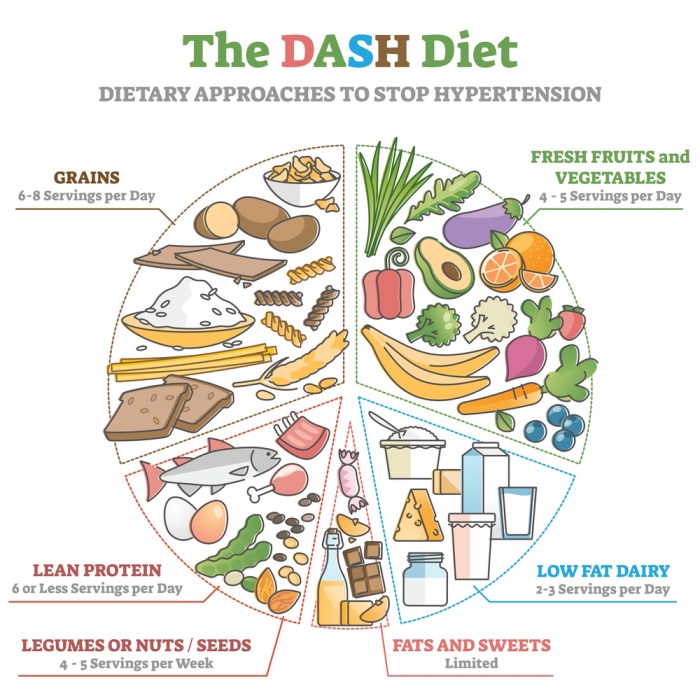
While adopting a healthy diet can significantly contribute to lowering blood pressure, it’s crucial to remember that it shouldn’t replace professional medical advice. Consulting a healthcare professional is essential for personalized guidance and effective management of high blood pressure.
Personalized Dietary Advice
A registered dietitian or a doctor specializing in nutrition can provide tailored dietary recommendations based on your individual needs, medical history, and current blood pressure levels. They can help you identify specific foods to emphasize or limit, considering any existing allergies, intolerances, or medications you might be taking.
Monitoring Blood Pressure
Regularly monitoring your blood pressure is crucial for tracking your progress and identifying any potential concerns. You can use a home blood pressure monitor or visit your doctor for regular checkups.
It’s essential to keep a record of your blood pressure readings and share them with your healthcare provider during your appointments. They can then assess your progress and adjust your treatment plan accordingly.
Role of Medication
In some cases, lifestyle changes alone may not be sufficient to manage high blood pressure effectively. Your doctor might recommend medication to help lower your blood pressure to a safe level.
There are various types of medications available, and your doctor will choose the most appropriate option based on your individual needs and health condition.
It’s important to take medication as prescribed and follow your doctor’s instructions carefully.
Concluding Remarks
Embracing a diet rich in fruits, vegetables, whole grains, and lean protein, while limiting sodium, saturated fats, and processed foods, can significantly impact blood pressure. Remember, a healthy lifestyle is a holistic approach, encompassing regular exercise, stress management, and adequate sleep. Consult a healthcare professional for personalized guidance and to monitor your progress.
Answers to Common Questions
What are the symptoms of high blood pressure?
High blood pressure often has no symptoms. It’s important to get regular checkups to monitor your blood pressure.
Can I lower my blood pressure without medication?
Lifestyle changes, including diet and exercise, can significantly lower blood pressure. However, in some cases, medication may be necessary.
How often should I check my blood pressure?
Talk to your doctor about how often to check your blood pressure based on your individual needs.
Is it okay to eat salt if I have high blood pressure?
Limiting sodium intake is crucial for managing high blood pressure. Aim for a low-sodium diet.
Finding the best diet to lower blood pressure can be a journey, and it’s important to understand what we mean by “diet” in this context. It’s not about restrictive fads, but rather a long-term lifestyle change focused on nourishing your body with the right foods.
If you’re curious about the true meaning of “diet,” you can check out this helpful resource: what does diet mean. With a balanced and mindful approach, you can create a dietary plan that supports healthy blood pressure levels and overall well-being.
A diet rich in fruits, vegetables, and whole grains is often recommended to help lower blood pressure. But what about our furry friends? You might be wondering if a raw diet, like the one discussed in this article on is raw diet good for dogs , is beneficial for dogs.
While a raw diet can be a healthy option for some dogs, it’s crucial to consult your veterinarian before making any drastic dietary changes, especially when it comes to blood pressure management.
A diet rich in fruits, vegetables, and whole grains is often recommended to lower blood pressure. This type of eating plan also aligns with the principles of the best diet to lose weight for diabetics , which emphasizes controlled carbohydrate intake and healthy fats.
By focusing on these dietary components, you can potentially improve both your blood pressure and your overall health.


